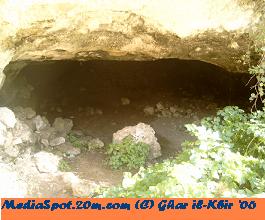Ghar il-Kbir
The amazing cave people of Malta
There was ‘no place like home’ to the cave dwellers of Ghar il-Kbir. Foreigners were struck by their intense devotion to cave life.
‘These people are so tied to their cave that when they have to go to the city of Melita either to sell their merchandise or in order to buy their needs, they feel as if they were condemned to exile and no sooner do they finish their errands, than they hurry back to their caves lest they spend even one night away.’ Kircher, 16371
‘these Maltese Troglodytes, rather chose to bury themselves, as it were, alive, by inhabiting the dark and solitary Caverns of the Earth, than to live above ground in Houses.' Veryard, 17012
The discovery of modern cave dwellers should not surprise us. But evolutionary ideas have brainwashed us to believe that cave dwellers are ‘primitive’. We need to remember that evidence must be interpreted, does not speak for itself. If Christians look at cave dwellers through biblical glasses, they should realize that Noah’s descendants chose to live in caves, perhaps for convenience or personal preference, but not because they were brainless brutes!
References
1. Zammit Ciantar, J., Life at Ghar il-Kbir, Dingli Local Council, Malta, p. 11, 2000.
2. Veryard, E., An Account of Divers Choice Remarks, as well Geographical, as Historical, Political, Mathematical, Physical, and Moral; taken in a Journey through the Low-Countries, France, Italy, and Part of Spain; with the isles of Sicily and Malta, Sam Farley, London, pp. 233‚ 236, 1701.
Source
The Story
In the Maltese Islands, caves have been used since antiquity. Excavations at Ghar Dalam gave pottery dating back to the Neolithic, while the hypogeum at the Xaghra Stone Circle originated as an underground cave. Evidence for cave use has been found for the Bronze Age (Il-Qlejgha), the Roman Period (Ghar ta' l-Iburdan) and has been proposed for the Phoenician Period (Ghar is-Sigra).
The use of caves as a dwelling place in the medieval period is a phenomenon of considerable interest, which is slowly recieving recognition. Various natural recesses on the islands together with a number of tombs were converted into the abode of medieval troglodytes.
One of the best known sites featuring medieval troglodytism exists at a number of caves at Misrah Ghar il-Kbir, known as Ghar il-Kbir. Similar to contemporary sites in Sicily, existing cave space was closed through the use of rubble walls, while new space was created by digging into the sidewalls of the caves.
Athanasius Kircher describes vividly the way of life in this cave during the seventeenth century. The troglodytes lived in separate units hewn or built out of the cave, and stored water in earthenware jars. Every family had its hearth and used dried dung as fuel. Bunches of onions and garlic greeted the visitors and humans lived side by side to animals.
About this site
This site is aimed at promoting this beautiful location of the Maltese islands. You will find many photos all taken by myself, and information about the area and its history gathered from different sources. I hope you enjoy this site and find the time to visit and appreciate this wonderful heritage of the Maltese people.
Alexis Callus
From Joseph Mizzi, M.D., MRCP (UK), who has visited Ghar il-Kbir, is a paediatrician in the Neonatal Intensive Care Unit, St. Luke’s Hospital, Malta.
Ghar il-Kbir (the Great Cave) is the best-known of these settlements. It consists of eight smaller caves, on two different levels, surrounding a large natural cavern. The roof of the cavern (technically called a ‘karst hollow’) has collapsed. The cave dwellers inhabit the smaller caves, having built stone walls inside (as well as at the entrance) to separate their living quarters. There is no evidence of wall painting (which is found at some other sites), but there are various works in stone, loops in the ceiling, ducts, shelves and niches, which evidently served practical purposes.
The date of the earliest settlement at Ghar il-Kbir is unknown, but the first known mention of it, in 1544, is a reference to Simone Camilleri de gar il-chibir (Simone Camilleri of the Great Cave). The Maltese historian Giovanni Francesco Abela includes Ghar il-Kbir in his list of inhabited places on the island. He describes it as a vast cavern where 117 people lived, grouped in 27 families.7 They were pastori e pecorai, ‘shepherds and sheep-herders’. Read More
Extracted from the website of Mr. Anton Bugeja (See Favorite Links)
A first-hand ‘tourist’ account
Ghar il-Kbir became a mini ‘tourist attraction’ among the travellers of that day. Imagine visiting a real-life community in a cave. The published account of a German visitor, Athanasius Kircher, was most vivid:
‘In 1637, when I was in Malta, [my host mentioned] that there was a hill in the vicinity where people who were his subjects live underground. He expressed the wish that I go and see them and admire the art with which they adorn these caves and how they organize the place where they live.'
Produced by:


